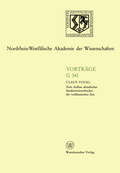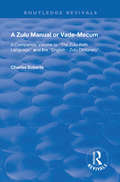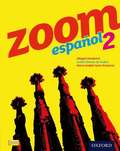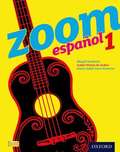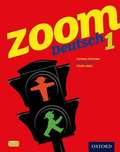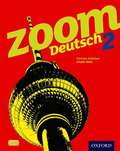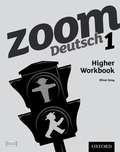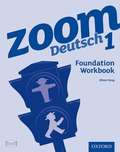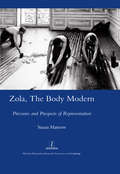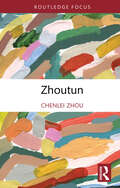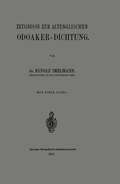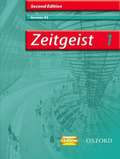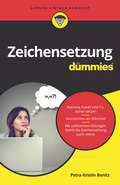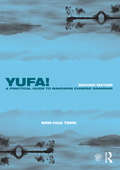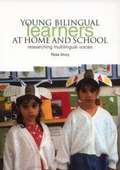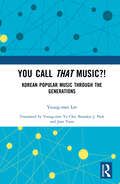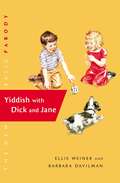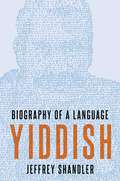- Table View
- List View
Zum Aufbau altindischer Sanskritwörterbücher der vorklassischen Zeit (Nordrhein-Westfälische Akademie der Wissenschaften #341)
by Claus VogelA Zulu Manual or Vade-Mecum: A Companion Volume to ''The Zulu-Kafir Language'', And The '' English - Zulu Dictonary''. (Routledge Revivals)
by Charles RobertsPublished in 1900, this book provides a companion volume to the Zulu Kafir Language and the English Zulu Dictionary. Including a dictionary and examples of language structure and grammar, this book makes Zulu accessible to all levels of learner.
A Zulu Manual or Vade-Mecum: A Companion Volume to ''The Zulu-Kafir Language'', And The '' English - Zulu Dictonary''. (Routledge Revivals)
by Charles RobertsPublished in 1900, this book provides a companion volume to the Zulu Kafir Language and the English Zulu Dictionary. Including a dictionary and examples of language structure and grammar, this book makes Zulu accessible to all levels of learner.
Zoom Español, Level 2
by Isabel Alonso de Sudea Abigail Hardwick Maria Isabel Isern VivancosZoom espanol is an inspiring two-part Spanish course offering fresh, exciting material and a fully-integrated video drama for the full ability range at grades 6-8. There is a clear route through for students following both two-year and three-year courses so students and teachers know exactlyhow much material needs to be covered. Zoom espanol delivers the revised Grade 6-8 Programme of Study, PLTS and the Renewed Framework. The Zoom espanol course has a full suite of differentiated resources to support your needs: Student Books, Teacher Books, Foundation and Higher Workbooks, Audio CDs, Interactive OxBox CD-ROM and Assessment OxBox CD-ROM. The Zoom espanol 2 Student Book is full of inspiring activities to suit all learner types. Each unit links to a video clip and video-blog of four teenagers from Barcelona providing students with a real insight into Spanish-speaking people and their life. As well as plenty of engaging activities tosupport listening, reading, speaking and writing there are also pages in every unit dedicated to grammar, study skills and pronunciation support. Further cultural reading material is provided for every unit so that students can learn about life in Spain and Spanish-speaking countries.
Zoom Español, Level 1 (PDF)
by Isabel Alonso de Sudea María Isabel Isern Vivancos Abigail HardwickZoom espanol is an inspiring two-part Spanish course offering fresh, exciting material and a fully-integrated video drama for the full ability range at Grades 6-8. There is a clear route through for students following both two-year and three-year courses so students and teachers know exactlyhow much material needs to be covered. Zoom espanol delivers the revised Grade 6-8 Programme of Study, PLTS and the Renewed Framework. The Zoom espanol course has a full suite of differentiated resources to support your needs: Student Books, Teacher Books, Foundation and Higher Workbooks, Audio CDs, Interactive OxBox CD-ROM and Assessment OxBox CD-ROM. The Zoom espanol 1 Student Book is full of inspiring activities to suit all learner types. Each unit links to a video clip and video-blog of four teenagers from Barcelona providing students with a real insight into Spanish-speaking people and their life. As well as plenty of engaging activities tosupport listening, reading, speaking and writing there are also pages in every unit dedicated to grammar, study skills and pronunciation support. Further cultural reading material is provided for every unit so that students can learn about life in Spain and Spanish-speaking countries.
Zoom Deutsch, Level 1 student book (PDF)
by Corinna Schicker Marcus Waltl Chalin MalzZoom Deutsch is an inspiring two-part German course offering fresh, exciting material and a fully-integrated video drama for the full ability range at grades 6-9. There is a clear route through for students following both two-year and three-year courses so students and teachers know exactlyhow much material needs to be covered. Zoom Deutsch delivers the revised Programme of Study, PLTS and the Renewed Framework. The Zoom Deutsch course has a full suite of differentiated resources to support your needs: Student Books, Teacher Books, Foundation and Higher Workbooks, Audio CDs, Interactive OxBox CD-ROM and Assessment OxBox CD-ROM. This Zoom Deutsch 1 Student Book is full of inspiring activities to suit all learner types. Each unit links to a video clip and video-blog of four teenagers from Berlin providing students with a real insight into German people and German life. As well as plenty of engaging activities to supportlistening, reading, speaking and writing there are also pages in every unit dedicated to grammar, study skills and pronunciation support. Further cultural reading material is provided for every unit so that students can learn about life in Germany, Austria and Switzerland.
Zoom Deutsch 2: Student Book (PDF)
by Chalin Malz Corinna SchickerZoom Deutsch is an inspiring two-part German course offering fresh, exciting material and a fully-integrated video drama for the full ability range at KS3. There is a clear route through for students following both two-year and three-year courses so students and teachers know exactly how much material needs to be covered. Zoom Deutsch delivers the revised KS3 Programme of Study, PLTS and the Renewed Framework.The Zoom Deutsch course has a full suite of differentiated resources to support your needs: Student Books, Teacher Books, Foundation and Higher Workbooks, Audio CDs, Interactive OxBox CD-ROM and Assessment OxBox CD-ROM.This Zoom Deutsch 1 Student Book is full of inspiring activities to suit all learner types. Each unit links to a video clip and video-blog of four teenagers from Berlin providing students with a real insight into German people and German life. As well as plenty of engaging activities to support listening, reading, speaking and writing there are also pages in every unit dedicated to grammar, study skills and pronunciation support. Further cultural reading material is provided for everyunit so that students can learn about life in Germany, Austria and Switzerland.
Zoom Deutsch 1 Higher Workbook (Zoom Ser.)
by Oliver GrayZoom Deutsch is an inspiring two-part German course offering fresh, exciting material and a fully-integrated video drama for the full ability range at KS3. There is a clear route through for students following both two-year and three-year courses so students and teachers know exactly how much material needs to be covered. Zoom Deutsch delivers the revised KS3 Programme of Study, PLTS and the Renewed Framework. The Zoom Deutsch course has a full suite of differentiated resources to support your needs: Student Books, Teacher Books, Foundation and Higher Workbooks, Audio CDs, Interactive OxBox CD-ROM and Assessment OxBox CD-ROM. This Zoom Deutsch 1 Higher Workbook is full of extra listening, reading, writing and speaking material to extend the grammar, topics and skills learnt in the Student Book. The Higher Workbook is ideal for homework and further practice either during or outside of lesson time.
Zoom Deutsch. 1 Foundation Workbook (PDF)
by Vincent Everett Oliver GrayZoom Deutsch is an inspiring two-part German course offering fresh, exciting material and a fully-integrated video drama for the full ability range at Grades 6-9. There is a clear route through for students following both two-year and three-year courses so students and teachers know exactlyhow much material needs to be covered. Zoom Deutsch delivers the revised Grade 6-8 Programme of Study, PLTS and the Renewed Framework. The Zoom Deutsch course has a full suite of differentiated resources to support your needs: Student Books, Teacher Books, Foundation and Higher Workbooks, Audio CDs, Interactive OxBox CD-ROM and Assessment OxBox CD-ROM. This Zoom Deutsch 1 Foundation Workbook is full of extra listening, reading, writing and speaking material to reinforce and support the grammar, topics and skills learnt in the Student Book. It is ideal for homework and further practice either during or outside of lesson time. 9780199128105
Zola, The Body Modern: Pressures and Prospects of Representation
by Susan HarrowEmile Zola's reputation as a landmark European novelist is undisputed. His monumental achievement, the novel cycle Les Rougon-Macquart: Histoire sociale et naturelle d'une famille sous le Second Empire (1871-1893), fixed his status as a major writer in the naturalist tradition. Is there any more to be said? Susan Harrow answers boldly in the affirmative, challenging the commonplace view that Zola's writing is predictable, prolix and transparent (what Barthes called 'readerly', for which read 'tedious'). Harrow exposes the modernist and postmodernist strategies which surface in the Rougon-Macquart novels, and reveals Zola's innovatory representation of the body captured here at work, at war, at play, at rest, and in arresting abstraction. Informed by critical thought from Barthes and Deleuze to Michel de Certeau and Anthony Giddens, Zola, the Body Modern offers a model for how we can revitalize our understanding of the canonical nineteenth-century European novel, and learn to travel more flexibly between parameters of century, style and aesthetics.
Zola, The Body Modern: Pressures and Prospects of Representation
by Susan HarrowEmile Zola's reputation as a landmark European novelist is undisputed. His monumental achievement, the novel cycle Les Rougon-Macquart: Histoire sociale et naturelle d'une famille sous le Second Empire (1871-1893), fixed his status as a major writer in the naturalist tradition. Is there any more to be said? Susan Harrow answers boldly in the affirmative, challenging the commonplace view that Zola's writing is predictable, prolix and transparent (what Barthes called 'readerly', for which read 'tedious'). Harrow exposes the modernist and postmodernist strategies which surface in the Rougon-Macquart novels, and reveals Zola's innovatory representation of the body captured here at work, at war, at play, at rest, and in arresting abstraction. Informed by critical thought from Barthes and Deleuze to Michel de Certeau and Anthony Giddens, Zola, the Body Modern offers a model for how we can revitalize our understanding of the canonical nineteenth-century European novel, and learn to travel more flexibly between parameters of century, style and aesthetics.
Zhoutun (Routledge World Languages)
by Chenlei ZhouThis book presents a description of the grammar of Zhoutun, an endangered Sinitic variety spoken by less than 1000 people in the Qinghai Province of northwest China. With vocabulary predominantly from Chinese and Tibetan syntax, Zhoutun is one of the Sinitic varieties most distant from Standard Chinese, with unexpected typological features like, for example, case markers, rigid SOV word order, simplified tonal system, negative copula as a disjunctive coordinator and "locutor-referential pronoun" which is not found in Chinese and in many languages. Zhoutun is also a representative variety of the Gansu-Qinghai linguistic area in which Mongolic and Turkic languages coexist with Tibetan and Chinese dialects from a long time. This book also describes the sociolinguistic and sociohistorical contexts of Zhoutun. It should be of interest to specialists and students of language contact, linguistic typology, Chinese dialectology, language geography, anthropological linguistics, sociolinguistics, folklore studies, and preservation of endangered languages.
Zhoutun (Routledge World Languages)
by Chenlei ZhouThis book presents a description of the grammar of Zhoutun, an endangered Sinitic variety spoken by less than 1000 people in the Qinghai Province of northwest China. With vocabulary predominantly from Chinese and Tibetan syntax, Zhoutun is one of the Sinitic varieties most distant from Standard Chinese, with unexpected typological features like, for example, case markers, rigid SOV word order, simplified tonal system, negative copula as a disjunctive coordinator and "locutor-referential pronoun" which is not found in Chinese and in many languages. Zhoutun is also a representative variety of the Gansu-Qinghai linguistic area in which Mongolic and Turkic languages coexist with Tibetan and Chinese dialects from a long time. This book also describes the sociolinguistic and sociohistorical contexts of Zhoutun. It should be of interest to specialists and students of language contact, linguistic typology, Chinese dialectology, language geography, anthropological linguistics, sociolinguistics, folklore studies, and preservation of endangered languages.
Zeitgeist 1. German AS (PDF)
by Morag Mccrorie Dagmar Sauer Ann AdlerThis new 2008 edition of this popular course has been fully revised to support the new specifications.
Zeichensetzung für Dummies (Für Dummies)
by Petra-Kristin BonitzIst bei Ihnen die Zeichensetzung eher Gefühlssache? Sind Sie manchmal unsicher, wo ein Komma stehen muss und wo nicht? Dann schafft dieses Buch Abhilfe! Systematisch und gut verständlich erklärt Ihnen Petra-Kristin Bonitz, warum Satzzeichen gesetzt werden. Sie bringt Ihnen Satzstrukturen wieder ins Gedächtnis und erklärt anschaulich die Regeln, aber auch die Freiheiten im Rahmen der Zeichensetzung. Erfahren Sie zum Beispiel, ob und wie Sie Kommas bei Aufzählungen, Nebensätzen oder Infinitiven mit ?zu? setzen oder das eher exotische Semikolon verwenden. Darüber hinaus lassen sich Satzzeichen als Stilmittel einsetzen - Gedankenstrich, runde Klammern oder doch lieber der Doppelpunkt? Zahlreiche Übungen helfen Ihnen, das Gelernte anzuwenden und zu trainieren.
Yufa! A Practical Guide to Mandarin Chinese Grammar (Routledge Concise Grammars)
by Wen-Hua TengYufa! A Practical Guide to Mandarin Chinese Grammar takes a unique approach to explaining the major topics of Mandarin Chinese grammar. The book is presented in two sections: the core structures of Chinese grammar, and the practical use of the Chinese language. Key features include: Chinese characters, pinyin and English translations Realistic scenarios to provide you with an interesting context in which to learn grammar Varied and imaginative exercises so you can review your progress easily.With straightforward descriptions, numerous exercises, and examples that are rooted in realistic situations, the author shows you how grammar is used in everyday life. This new second edition has been fully revised and updated throughout and continues to be one of the clearest and most comprehensive pedagogical grammars available.
Yufa! A Practical Guide to Mandarin Chinese Grammar (Routledge Concise Grammars)
by Wen-Hua TengYufa! A Practical Guide to Mandarin Chinese Grammar takes a unique approach to explaining the major topics of Mandarin Chinese grammar. The book is presented in two sections: the core structures of Chinese grammar, and the practical use of the Chinese language. Key features include: Chinese characters, pinyin and English translations Realistic scenarios to provide you with an interesting context in which to learn grammar Varied and imaginative exercises so you can review your progress easily.With straightforward descriptions, numerous exercises, and examples that are rooted in realistic situations, the author shows you how grammar is used in everyday life. This new second edition has been fully revised and updated throughout and continues to be one of the clearest and most comprehensive pedagogical grammars available.
Young Bilingual Learners at Home and School: Researching Multilingual Voices (PDF)
by Rose DruryBased on the author's ethnographic study, this book examines the experiences of three four-year-old bilingual children as they begin school in three English nursery classes. It thus provides insights into young children's use of first languages as well as English, so provides a fuller and richer picture of bilingual children's learning. The book reveals some of the ways young bilingual children experience nursery as they begin to learn the language required for formal schooling. It demonstrates how they take control of their own learning at home. And it asks questions: How do Samia, Maria and Nazma find their own way through nursery? What are their individual strategies for getting by and, beyond that, for learning during their first year of formal schooling? How do they syncretise home and school learning? The detailed picture that emerges fills in the detail missing from the current over-generalised view of bilingual children in the early years and provides an important new perspective to a growing body of literature on young bilinguals. It will be essential reading for all teachers, early childhood practitioners and early years policy makers operating in multilingual environments.
You Call That Music?!: Korean Popular Music Through the Generations
by Young-mee LeeYou Call That Music?!: Korean Popular Music Through the Generations provides a critical overview of the history of Korean popular music from 1920 to the 2000s from the perspective of cultural history. First published in Korean in 2017 by one of the best-known critics, Lee Young-Mee, this book is a timely and much-needed source of information on Korean popular music of the past hundred years. Through this English translation, readers are able to make meaningful connections between specific forms of Korean popular music of various periods and the contemporaneous Korean social and political circumstances. Structured around the central theme of generational conflict, the book provides readers with an accessible way to engage with Korea’s social history and a greater understanding of how specific musical works, genres and styles fit into that history. Its strong narrative force helps illuminate the connections between modern Korean social history and the particular trends of musical production and their reception through the decades. You Call That Music?! is an invaluable resource for those researching and studying Korean popular music specifically as well as Korea’s cultural and social history.
You Call That Music?!: Korean Popular Music Through the Generations
by Young-mee LeeYou Call That Music?!: Korean Popular Music Through the Generations provides a critical overview of the history of Korean popular music from 1920 to the 2000s from the perspective of cultural history. First published in Korean in 2017 by one of the best-known critics, Lee Young-Mee, this book is a timely and much-needed source of information on Korean popular music of the past hundred years. Through this English translation, readers are able to make meaningful connections between specific forms of Korean popular music of various periods and the contemporaneous Korean social and political circumstances. Structured around the central theme of generational conflict, the book provides readers with an accessible way to engage with Korea’s social history and a greater understanding of how specific musical works, genres and styles fit into that history. Its strong narrative force helps illuminate the connections between modern Korean social history and the particular trends of musical production and their reception through the decades. You Call That Music?! is an invaluable resource for those researching and studying Korean popular music specifically as well as Korea’s cultural and social history.
Yiddish with Dick and Jane
by Ellis Weiner Barbara DavilmanJane is in real estate. Today is Saturday. Jane has an open house. She must schlep the Open House signs to the car. See Jane schlep. Schlep, Jane. Schlep. Schlep, schlep, schlep. In text that captures the unque rhythms of the original Dick and Jane readers, and in 35 all-new illustrations, a story unfolds in which Dick and Jane -- hero and heroine of the classic books for children that generations of Americans have used when learning to read -- manage to express shades of feeling and nuances of meaning that ordinary English just can't deliver. How? By speaking Yiddish, employing terms that convey an attitude -- part plucky self-assertion, part ironic fatalism. When Dick schmoozes, when Jane kvetches, when their children fress noodles at a Chinese restaurant, the clash of cultures produces genuine hilarity.
Yiddish: Biography of a Language
by Jeffrey ShandlerThe most widely spoken Jewish language on the eve of the Holocaust, Yiddish continues to play a significant role in Jewish life today, from Hasidim for whom it is a language of daily life to avant-garde performers, political activists, and LGBTQ writers turning to Yiddish for inspiration. Yiddish: Biography of a Language presents the story of this centuries-old language, the defining vernacular of Ashkenazi Jews, from its origins to the present. Jeffrey Shandler tells the multifaceted history of Yiddish in the form of a biographical profile, revealing surprising insights through a series of thematic chapters. He addresses key aspects of Yiddish as the language of a diasporic population, whose speakers have always used more than one language. As the vernacular of a marginalized minority, Yiddish has often been held in low regard compared to other languages, and its legitimacy as a language has been questioned. But some devoted Yiddish speakers have championed the language as embodying the essence of Jewish culture and a defining feature of a Jewish national identity. Despite predictions of the demise of Yiddish-dating back well before half of its speakers were murdered during the Holocaust-the language leads a vibrant, evolving life to this day.
Yiddish: Biography of a Language
by Jeffrey ShandlerThe most widely spoken Jewish language on the eve of the Holocaust, Yiddish continues to play a significant role in Jewish life today, from Hasidim for whom it is a language of daily life to avant-garde performers, political activists, and LGBTQ writers turning to Yiddish for inspiration. Yiddish: Biography of a Language presents the story of this centuries-old language, the defining vernacular of Ashkenazi Jews, from its origins to the present. Jeffrey Shandler tells the multifaceted history of Yiddish in the form of a biographical profile, revealing surprising insights through a series of thematic chapters. He addresses key aspects of Yiddish as the language of a diasporic population, whose speakers have always used more than one language. As the vernacular of a marginalized minority, Yiddish has often been held in low regard compared to other languages, and its legitimacy as a language has been questioned. But some devoted Yiddish speakers have championed the language as embodying the essence of Jewish culture and a defining feature of a Jewish national identity. Despite predictions of the demise of Yiddish-dating back well before half of its speakers were murdered during the Holocaust-the language leads a vibrant, evolving life to this day.
